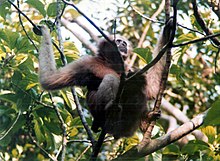Hoolock gibbon
| Hoolock gibbons[1][2] | |
|---|---|

| |
| Scientific classification | |
| Kingdom: | |
| Phylum: | |
| Class: | |
| Order: | |
| Family: | |
| Genus: | Hoolock |
| Species | |
The hoolock gibbons are two primate species of genus Hoolock in the gibbon family, Hylobatidae, native to eastern Bangladesh, Northeast India and Southwest China.
Hoolocks are the second-largest of the gibbons, after the siamang. They reach a size of 60 to 90 cm and weigh 6 to 9 kg. The sexes are about the same size, but they differ considerably in coloration: males are black-colored with remarkable white brows, while females have a grey-brown fur, which is darker at the chest and neck. White rings around their eyes and mouths give their faces a mask-like appearance.
In northeast India, the hoolock is found south of Brahmaputra and east of the Dibang Rivers.[3] Its range extends into seven states covering Arunachal Pradesh, Assam, Manipur, Meghalaya, Mizoram, Nagaland, and Tripura (The seven northeastern states of India).[4][5]
Like the other gibbons, they are diurnal and arboreal, brachiating through the trees with their long arms. They live together in monogamous pairs, which stake out a territory. Their calls serve to locate family members and ward off other gibbons from their territory. Their diet consists mainly of fruits, insects and leaves.
Young hoolocks are born after a seven-month gestation, with milky white or buff-colored hair. After about six months, the hair of males will darken and turn black, while the female hair remains buff-colored throughout her life. After eight to 9 years, they are fully mature and their fur reaches its final coloration. Their life expectancy in the wild is about 25 years.
Classification

The classification of this gibbon has changed several times in the past few years. Classically, all gibbons were classified in the genus Hylobates, with the exception of the siamang. After some studies, the genus was divided into three subgenera (including the siamang's Symphalangus), and then into four (recognizing Bunopithecus as the hoolock subgenus distinct from other gibbon subgenera). These four subgenera were elevated to full genus status. However, the type species for Bunopithecus is Bunopithecus sericus, an extinct gibbon or gibbon-like ape from Sichuan, China. Very recent investigations have shown the hoolocks are not closely related to B. sericus, so have been placed in their own genus, Hoolock. In the process, the two subspecies of hoolocks have been raised to species level.[1][2] A new subspecies has been described recently from northeastern India, which has been named Mishmi Hills hoolock, Hoolock hoolock mishmiensis.[6]
The two species of hoolock are:[2]
- Western hoolock gibbon, Hoolock hoolock
- Eastern hoolock gibbon, Hoolock leuconedys
References
- ^ a b Groves, C. P. (2005). "Order Primates". In Wilson, D. E.; Reeder, D. M (eds.). Mammal Species of the World: A Taxonomic and Geographic Reference (3rd ed.). Johns Hopkins University Press. pp. 178–179. ISBN 978-0-8018-8221-0. OCLC 62265494.
- ^ a b c Mootnick, A.; Groves, C. P. (2005). "A new generic name for the hoolock gibbon (Hylobatidae)". International Journal of Primatology. 26 (26): 971–976. doi:10.1007/s10764-005-5332-4.
- ^ Choudhury, A.U. (1987) Notes on the distribution and conservation of Phayre’s leaf monkey and Hoolock gibbon in India. Tigerpaper 14(2): 2-6
- ^ Choudhury, A.U. (1991) Ecology of the Hoolock gibbon, a lesser ape in the tropical forests of North-eastern India. J. Tropical Ecology 7: 147-153. Cambridge.
- ^ Choudhury, A.U. (2006) The distribution and status of hoolock gibbon, Hoolock hoolock, in Manipur, Meghalaya, Mizoram, and Nagaland in Northeast India. Primate Conservation 20: 79-87
- ^ Choudhury, A.U. (2013) Description of a new subspecies of Hoolock gibbon Hoolock hoolock from North East India. NL. & J. the Rhino Foundation for nature in North East Indiua 9: 49-59.
